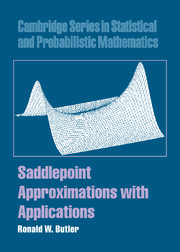Book contents
- Frontmatter
- Contents
- Preface
- 1 Fundamental approximations
- 2 Properties and derivations
- 3 Multivariate densities
- 4 Conditional densities and distribution functions
- 5 Exponential families and tilted distributions
- 6 Further exponential family examples and theory
- 7 Probability computation with p*
- 8 Probabilities with r*-type approximations
- 9 Nuisance parameters
- 10 Sequential saddlepoint applications
- 11 Applications to multivariate testing
- 12 Ratios and roots of estimating equations
- 13 First passage and time to event distributions
- 14 Bootstrapping in the transform domain
- 15 Bayesian applications
- 16 Nonnormal bases
- References
- Index
13 - First passage and time to event distributions
Published online by Cambridge University Press: 25 February 2010
- Frontmatter
- Contents
- Preface
- 1 Fundamental approximations
- 2 Properties and derivations
- 3 Multivariate densities
- 4 Conditional densities and distribution functions
- 5 Exponential families and tilted distributions
- 6 Further exponential family examples and theory
- 7 Probability computation with p*
- 8 Probabilities with r*-type approximations
- 9 Nuisance parameters
- 10 Sequential saddlepoint applications
- 11 Applications to multivariate testing
- 12 Ratios and roots of estimating equations
- 13 First passage and time to event distributions
- 14 Bootstrapping in the transform domain
- 15 Bayesian applications
- 16 Nonnormal bases
- References
- Index
Summary
In engineering reliability and multistate survival analysis, the machine or patient is viewed as a stochastic system or process which passes from one state to another over time. In many practical settings, the state space of this system is finite and the dynamics of the process are modelled as either a Markov process or alternatively as a semi-Markov process if aspects of the Markov assumption are unreasonable or too restrictive.
This chapter gives the CGFs connected with first passage times in general semi-Markov models with a finite number of states as developed in Butler (1997, 2000, 2001). Different formulae apply to different types of passage times, however all of these CGF formulae have one common feature: they are all represented as explicit matrix expressions that are ratios of matrix determinants. When inverting these CGFs using saddlepoint methods, the required first and second derivatives are also explicit so that the whole saddlepoint inversion becomes a simple explicit computation. These ingredients when used with the parametric plot routine in Maple, lead to explicit plots for the first passage density or CDF that completely avoid the burden of solving the saddlepoint equation.
Distributions for first passage or return times to a single absorbing state are considered in section 13.2 along with many examples derived from various stochastic models that arise in engineering reliability and queueing theory. Distributions for first passage to a subset of states require a different CGF formula which is developed in section 13.3. Passage times for birth and death processes can be approached from a slightly different perspective due to the movement restriction to neighboring states.
- Type
- Chapter
- Information
- Saddlepoint Approximations with Applications , pp. 430 - 473Publisher: Cambridge University PressPrint publication year: 2007



